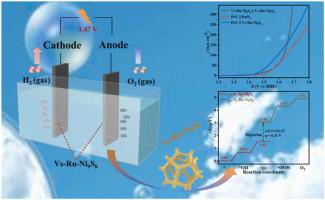Applied Catalysis B: Environment and Energy ( IF 20.2 ) Pub Date : 2022-03-28 , DOI: 10.1016/j.apcatb.2022.121356 Qin Gao 1 , Wei Luo 1 , Xueying Ma 1 , Zemian Ma 1 , Sijun Li 1 , Fenglin Gou 1 , Wei Shen 1 , Yimin Jiang 1 , Rongxing He 1 , Ming Li 1

|
Developing easy-to-make and excellent bifunctional electrocatalysts for water splitting over a wide pH range is a challenging yet appealing topic. Herein, based on integration of vacancy engineering and electronic modulation, a high-performance vs-Ru-Ni9S8 electrocatalyst for water splitting was constructed via a cost-effective one-step hydrothermal method. Under the synergistic regulation of Ru-doping and sulfur vacancies, the vs-Ru-Ni9S8 exhibited the outstanding electrocatalytic performance and long-time durability, along with ultra-low OER overpotentials of 218 and 268 mV at 100 and 300 mA cm−2 in alkaline electrolyte and low HER overpotentials of 56, 131, 94 mV at 10 mA cm−2 in acidic, neutral, alkaline electrolyte. Impressively, 1.47 and 1.68 V of voltages were needed to achieve 10 and 300 mA cm−2 for the vs-Ru-Ni9S8 (+, -) cell. Our DFT results revealed that the doping Ru atom played a crucial role in regulating electron density in OER, rather than served as a catalytic active site. More importantly, we corroborated the active Ni-vacancy pair composed of Ni atom and sulfur vacancy, as an active site, and its catalytic synergy in OER. Especially, a vacancy-metal synergetic mechanism for OER was suggested to correctly describe the OER process and the role of vacancy in catalytic process. Our work provides a simple and effective strategy for fabricating high-performance catalysts and an in-depth understanding of OER.
中文翻译:

Ni9S8的电子调制和空位工程协同提高高效水分解:活性空位-金属对
开发易于制造且性能优异的双功能电催化剂,用于在较宽的 pH 范围内进行水分解,这是一个具有挑战性但又颇具吸引力的课题。在此,基于空位工程和电子调制的集成,通过具有成本效益的一步水热法构建了一种用于水分解的高性能v s -Ru-Ni 9 S 8电催化剂。在Ru掺杂和硫空位的协同调控下,v s -Ru-Ni 9 S 8表现出优异的电催化性能和长期耐久性,在100和300 mA时具有218和268 mV的超低OER过电位厘米-2在碱性电解液中和在酸性、中性、碱性电解液中在 10 mA cm -2下 56、131、94 mV 的低 HER 过电位。令人印象深刻的是,v s -Ru-Ni 9 S 8需要 1.47 和 1.68 V 的电压来实现 10 和 300 mA cm -2(+, -) 单元格。我们的 DFT 结果表明,掺杂的 Ru 原子在调节 OER 中的电子密度方面起着至关重要的作用,而不是作为催化活性位点。更重要的是,我们证实了由 Ni 原子和硫空位组成的活性 Ni-空位对作为活性位点,及其在 OER 中的催化协同作用。特别是,提出了一种空位-金属OER协同机制,以正确描述OER过程和空位在催化过程中的作用。我们的工作为制造高性能催化剂和深入了解 OER 提供了一种简单有效的策略。















































 京公网安备 11010802027423号
京公网安备 11010802027423号